In this monthly series reviewing classic science fiction books, Alan Brown will look at the front lines and frontiers of science fiction; books about soldiers and spacers, explorers and adventurers. Stories full of what Shakespeare used to refer to as “alarums and excursions”: battles, chases, clashes, and the stuff of excitement.
Sometimes a book comes along that completely knocks you off your feet. A perfect example is A Fire Upon the Deep, by Vernor Vinge. It takes all the tropes of space opera, but grounds them in interesting speculations about physics. It is a war story, but told from the viewpoint of refugees fleeing that conflict. It is a heroic quest, but set in a far future society that travels between stars. It pushes all the emotional buttons, and keeps you on the edge of your seat right up to the last page. If you haven’t read it, consider this article a taste of what you’ve been missing. If you have read it, join me for a fond visit to an old favorite. There are a few spoilers ahead, but relatively gentle ones that describe the setting without revealing the plot past the first few chapters.
It’s often said, in a statement attributed to science fiction fan Peter Graham, that the golden age of science fiction is 12. The concept is easy to understand: the real golden age is not a period in time, but a period in life. At a young age, your sense of wonder has not been beaten into submission; you don’t have hundreds of books to measure the latest one against. Pretty much everything you read is something fresh. But every once in a while, a book comes along that gives even an older reader a thrill that compares with their first exposure to science fiction. I was in my late thirties when I encountered A Fire Upon the Deep, but for a few days, I felt like I was 12 again. This book had thoughtful extrapolation, thrilling adventure, fascinating aliens, fearsome opponents, and compelling protagonists. It’s no wonder it won the Hugo Award, science fiction’s highest popular award, the year after it appeared.
About The Author
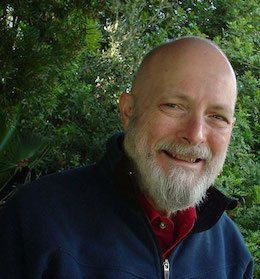 Vernor Vinge was born in 1944. In 1966 the young author sold his first science fiction story to John Campbell at Analog magazine, and he was a frequent contributor to magazines throughout the ‘60s and ‘70s. I remember his work as being satisfying, but more thoughtful than emotional. His “day job” while he wrote science fiction was in computer science, and he is now retired from a position as a San Diego State University Professor of Mathematics. His academic career informed his science fiction writing, and vice versa. One of Vinge’s notable works is a novelette from 1981, “True Names,” widely noted as a precursor to novels that use “cyberspace” as a setting. He is famous for an essay written in 1993, “The Coming Technological Singularity,” which is summarized in the following statement: “Within thirty years, we will have the technological means to create superhuman intelligence. Shortly after, the human era will be ended.” Vinge believes that this development will so transform society that stories from after the “singularity” would be incomprehensible to those living before the transformation.
Vernor Vinge was born in 1944. In 1966 the young author sold his first science fiction story to John Campbell at Analog magazine, and he was a frequent contributor to magazines throughout the ‘60s and ‘70s. I remember his work as being satisfying, but more thoughtful than emotional. His “day job” while he wrote science fiction was in computer science, and he is now retired from a position as a San Diego State University Professor of Mathematics. His academic career informed his science fiction writing, and vice versa. One of Vinge’s notable works is a novelette from 1981, “True Names,” widely noted as a precursor to novels that use “cyberspace” as a setting. He is famous for an essay written in 1993, “The Coming Technological Singularity,” which is summarized in the following statement: “Within thirty years, we will have the technological means to create superhuman intelligence. Shortly after, the human era will be ended.” Vinge believes that this development will so transform society that stories from after the “singularity” would be incomprehensible to those living before the transformation.
This essay was not the first time he addressed this concept—his 1986 novel, Marooned in Realtime, describes characters who were trapped in a stasis field during the “singularity” and found themselves emerging into another world. But Vinge found he had a tiger by the tale: his own best guesses for the future envision a world that would defy description. His solution to this dilemma was the developing a concept he called “The Zones of Thought.”
The Zones of Thought
My first encounter with the “Zones of Thought” concept was not A Fire Upon the Deep, published in 1992. Instead, it was a novelette, “The Blabber,” which appeared in New Destinies, Volume VI, the Winter 1988 edition. New Destinies was a magazine in paperback book format edited by Jim Baen and published by Baen Books (while he went from being a magazine editor to a book publisher, I don’t think Baen ever left his magazine roots behind). “The Blabber” describes a human colony world settled by emigrants from the American Great Lakes region. Both Earth and this new colony are located in the “Slow Zone,” a region where travel and communications are limited to the speed of light, and superhuman intelligence is impossible. Beneath this region, in the “Unthinking Depths,” even human-level intelligence is impossible (so much for the galactic core being the realm of elder races with advanced science). The fringes of the galaxy are the “Beyond,” where the speed of light is no longer a limiting factor, and superhuman beings and intelligences live.
In “The Blabber,” the human colony, located just within the Slow Zone, is visited by a trading expedition from the Beyond, looking to trade advanced technology for cultural artifacts from the humans. The story is a bravura effort, mixing thoughtful scientific extrapolation with wonders that would be right at home in the space opera tales of science fiction’s pulp era. Vinge found a way to escape the bounds of rigid extrapolation, but in a way that was internally consistent. There is a joy and sense of wonder in “The Blabber” that I had not seen in Vinge’s work before. So when I heard that A Fire Upon the Deep would be set in that same universe, I looked forward to it with great anticipation. Anticipation that was rewarded in abundance.
The Plot
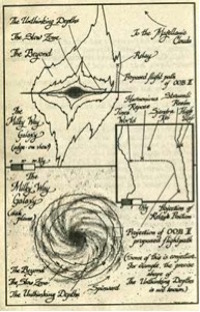 A Fire Upon the Deep opens with a description of an expedition from the human Straumli Realm to a long-lost archive just beyond the Beyond. In their attempt to gain information that could make their entire culture wealthy, the expedition instead uncovers an ancient evil, a malignant artificial intelligence that threatened the galaxy’s civilization in the distant past. Realizing what they have unleashed, the expedition attempts to flee in two spaceships. One is destroyed, while the other—carrying both the children of the expedition in suspended animation and also a secret that might lead to the undoing of the malignant intelligence—flees toward the Slow Zone looking for a habitable planet. The Olsndot family, piloting that ship, land on an unknown world, only to be attacked by its inhabitants, and only the young siblings Johanna and Jefri Olsndot survive, along with some of the children in suspended animation. They also end up separated, in the hands of two warring factions among the alien inhabitants.
A Fire Upon the Deep opens with a description of an expedition from the human Straumli Realm to a long-lost archive just beyond the Beyond. In their attempt to gain information that could make their entire culture wealthy, the expedition instead uncovers an ancient evil, a malignant artificial intelligence that threatened the galaxy’s civilization in the distant past. Realizing what they have unleashed, the expedition attempts to flee in two spaceships. One is destroyed, while the other—carrying both the children of the expedition in suspended animation and also a secret that might lead to the undoing of the malignant intelligence—flees toward the Slow Zone looking for a habitable planet. The Olsndot family, piloting that ship, land on an unknown world, only to be attacked by its inhabitants, and only the young siblings Johanna and Jefri Olsndot survive, along with some of the children in suspended animation. They also end up separated, in the hands of two warring factions among the alien inhabitants.
The inhabitants of this world, the Tines, are a species that communicates between its members by sound, and only in groups of 5-8 do these aliens reach human level intelligence. They are described as having a mix of dog and sea mammal characteristics, but because of their black and white coloration, affinity for traveling in groups, and their complex system of communication, they remind me of dolphins in the northern Pacific, colored like killer whales in black and white, who gather in groups to play on the bow waves of passing ships. Jefri is accidently placed with Amdi, a newly formed Tine pack, while Johanna falls in the hands of pair of traveling Tine packs, Peregrine and Scriber, who bring her to the area ruled by the Tine Woodcarver. Jefri forms a friendly bond with his captors, not realizing that their leader, Steel, heads a Nazi-like sect that practices eugenics in building their packs. At the same time, Johanna forms an adversarial relationship with the Tines around her, not realizing that they are a much more democratic and benevolent society. The children are on two sides of an impending war, with their ship and its treasures greatly coveted by both factions.
At the same time, on a world in the Beyond called Relay, a human librarian named Ravna Bergsndot has won an apprenticeship with the Vrimini Organization (in the information-based society of the Beyond, the role of a librarian is extremely expansive and complex). Relay is a major node in the galaxy-wide communications system called the Known Net, and her posting is an exciting step in her career. News of the malevolent intelligence released by the Straumli Realm explorers is beginning to spread, and it gains the nickname of the “Blight.” She meets a man named Pham Nuwen, who was resurrected from a crew member (the original Pham Nuwen) of a Slow Zone spaceship owned by the Qeng Ho trading organization. Ravna is a fan of old fairy tales, and Pham appears to her like a hero from the old tales brought back to life. He is the representative of a transcendent being known as the “Old One.” After a date, however, she finds that Pham is being used as kind of a human net terminal, allowing her to actually communicate directly with the Old One, a disconcerting experience.
The Vrimini Org receives a distress call from Jefri Olsndot and realizes that a countermeasure to the Blight might be aboard his crashed starship. Vrimini Org commissions a rescue expedition, hiring two Skrodriders, Blueshell and Greenstalk, and their cargo ship, the Out of Band II. Skrodriders are intelligent plants who have a symbiotic relationship with the mechanical carts that they ride, a relationship that has existed for uncounted millennia. While they are preparing the expedition, the Blight attacks Relay and destroys the Old One, while the Out of Band II, with Ravna, Pham, Blueshell and Greenstalk aboard, barely escapes the tragedy. They decided to attempt to carry out their commission, despite the fact that Vrimini Org may no longer exist.
As the Out of Band II travels to their rescue, Jefri and Johanna learn to cope with an alien world, learning more about the Tines and their culture. At the same time, Tine society is heading toward war, and the Woodcarver organization is riddled with spies and traitors. Steel is manipulating Jefri, planning to capture the rescue mission and use it to his advantage. From the Known Net comes news that whole civilizations are being absorbed into the Blight, and the galaxy explodes with warfare. Alien civilizations, knowing that it was humans who unleashed the Blight, head toward human worlds intent on genocide. The crew of the Out of Band II, pursued by hostile forces, finds that it will be difficult even to reach their destination, let alone aid the children and release the countermeasure.
The Ideas
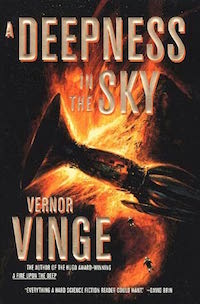 A bald summary of the plot of A Fire Upon the Deep is doomed to be as inadequate as an attempt by a human to describe a transcendent being. The story is, at its heart, an epic fantasy quest, but with energy weapons instead of swords. There is a surface level of action, adventure, and derring-do, but at the same time, there is some fascinating world-building going on. The Tines are unique, fascinating, and the implications of their pack intelligences are not only well thought out, but vital to the plot. The different Tine characters feel real despite their alien nature, and the way their personalities change as members are added and subtracted from their packs is fascinating. The alien nature of the Skrodriders is also compelling and consistent. The Known Net feels a lot like the Internet, which is an accomplishment, because when the book was written, the Internet had not quite reached its current ubiquitous state. Ravna is a plucky and resourceful heroine. Pham Nuwen is compelling and tragic at the same time, a human being manufactured to serve as a tool. And the child characters of Jefri and Johanna are well written and their behavior feels consistent with their ages. This is a book that makes you think and feel deeply at the same time; most of all, it’s a book you can enjoy on many different levels.
A bald summary of the plot of A Fire Upon the Deep is doomed to be as inadequate as an attempt by a human to describe a transcendent being. The story is, at its heart, an epic fantasy quest, but with energy weapons instead of swords. There is a surface level of action, adventure, and derring-do, but at the same time, there is some fascinating world-building going on. The Tines are unique, fascinating, and the implications of their pack intelligences are not only well thought out, but vital to the plot. The different Tine characters feel real despite their alien nature, and the way their personalities change as members are added and subtracted from their packs is fascinating. The alien nature of the Skrodriders is also compelling and consistent. The Known Net feels a lot like the Internet, which is an accomplishment, because when the book was written, the Internet had not quite reached its current ubiquitous state. Ravna is a plucky and resourceful heroine. Pham Nuwen is compelling and tragic at the same time, a human being manufactured to serve as a tool. And the child characters of Jefri and Johanna are well written and their behavior feels consistent with their ages. This is a book that makes you think and feel deeply at the same time; most of all, it’s a book you can enjoy on many different levels.
Final Thoughts
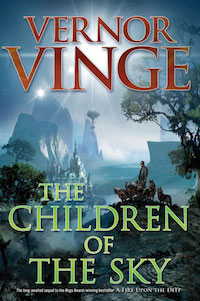 Vernor Vinge received the Hugo Award for A Fire Upon the Deep (tying with Connie Willis’ Doomsday Book), and it marked the start of a very productive period in his career. In 1999, he published A Deepness in the Sky, another Hugo winner, a prequel that describes an earlier adventure of Pham Nuwen in his days with the Qeng Ho, making contact with a spider-like alien race. A third novel in the Zones of Thought series, Children of the Sky, was released in 2011, and follows the adventures of Ravna, the Olsndot children, and the other children revived from hibernation, as they work to establish a new human civilization among the Tines. The scope of this story is not as epic, but it’s a good opportunity to visit some old familiar characters. Vinge has written a number of other books and stories, and won further Hugo Awards, most recently for the book Rainbows End—most of these are set in the near future, and address the impact of technology on society. Unfortunately for his many fans, though, Vinge is not as prolific a writer as some of us would like.
Vernor Vinge received the Hugo Award for A Fire Upon the Deep (tying with Connie Willis’ Doomsday Book), and it marked the start of a very productive period in his career. In 1999, he published A Deepness in the Sky, another Hugo winner, a prequel that describes an earlier adventure of Pham Nuwen in his days with the Qeng Ho, making contact with a spider-like alien race. A third novel in the Zones of Thought series, Children of the Sky, was released in 2011, and follows the adventures of Ravna, the Olsndot children, and the other children revived from hibernation, as they work to establish a new human civilization among the Tines. The scope of this story is not as epic, but it’s a good opportunity to visit some old familiar characters. Vinge has written a number of other books and stories, and won further Hugo Awards, most recently for the book Rainbows End—most of these are set in the near future, and address the impact of technology on society. Unfortunately for his many fans, though, Vinge is not as prolific a writer as some of us would like.
The Zones of Thought series, short though it is, contains some of the most compelling science fiction stories ever written. “The Blabber,” while it was the first tale to be written, is described by Vinge as the last in the series chronologically (you can find it, by the way, in the anthology The Collected Stories of Vernor Vinge). The story feels more like a beginning than an ending, though, and if we are lucky, we might see further tales of humans, Tines, and Skrodriders set in a Beyond full of strange beings, mysterious worlds, and thrilling dangers.
For now, I’m interested in your thoughts. Which of Vinge’s works have you read? What are your favorites? What do you think of the Zones of Thought concept? Do you find the Tines a believable species? And would you, like me, want to read more?
Alan Brown has been a science fiction fan for five decades, especially science fiction that deals with military matters, exploration and adventure. He is also a retired reserve officer with a background in military history and strategy










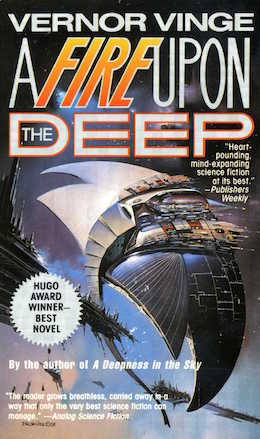
Vinge frequently offers us digital wonders of the not-so-far future but Amazon Web Services seemingly can’t stay online long enough for me to post a comment… I’m not concerned about the technological singularity yet.
Anyway, I think I have read all of Vinge’s stories at one point or another and remember the first two Zones of Thought stories as being, along with “True Names”, his best work (though it’s been a few years since I last read them). I liked the way that this book and A Deepness in the Sky can be read in either order and inform each other to create a kind of greater whole: they were certainly very influential on the “New Space Opera” movement.
ETA: A pedant revolts! The Campbell-acquisition “Bookworm, Run!” was Vinge’s US debut but “Apartness” appeared the previous year in Mike Moorcock’s UK magazine New Worlds. (When I think about it, I’m surprised by how long he’s been around. There’s even an oblique reference to him in The Fifth Head of Cerberus.)
VInge was less anticipating the Internet than riffing on Usenet, but Usenet is probably a closer fit for such a galaxy-wide network anyway.
I’ve read “Deep” several times, and the sections with Steel don’t hold up as well on re-read for me. “Deepness” has a lot more non-obvious stuff going on that make re-reads more enjoyable.
Computers never do what they should because they are already sentient and often don’t feel like cooperating with stupid requests by humans.
@3: So, are you saying that the reams of junk that the sentient computers permit to be published on the internet are part of a plot to destabilise human control of the digital realm? Interesting.
@3 @@.-@ Compters, like cats and kids, are devotees of the Demon of Perversity…
Hexapodia!!
I came to Vinge relatively late, about five years ago, despite devouring a lot of both modern and classic SciFi over the years. While they’re not my favorites, something about those early books just screams “Epic!” to me in a way that very few other works have. Also, the Skroderiders are just plain cool, regardless of their role in the overall plot.
You might be interested in the “annotated” edition of A Fire Upon the Deep, which I reviewed for Slashdot some time ago.
It’s an interesting curiosity, though I don’t know if it’s still available for sale anywhere. It includes all the various notes that Vinge and his editors made while in the process of writing, and a few deleted or changed scenelets. I bought it when it was sold via Peanut Press.
_Rainbows End_ without the apostrophe.
It is actually a plot point.
@9 – Fixed, thank you! (And now I want to reread that book!)
I find it hard to remember the plots of Vinge’s far future work (compared to something like True Names) but some of the ideas he introduced sure stayed with me. I love the computer software archaeology angle
I really enjoyed the spider characters in Deepness. I don’t have the book to check names but the mad-scientist guy was a riff on Mr Toad from Wind In The Willows. It even had him racing around in a motorcar scaring passengers and bystanders.
@1
Not many people were worried about atomic bombs on August 5th, 1945.
The future has a way of surprising people.
@1 Thanks for the info on Vinge’s first publication. I hadn’t realized that “Apartness” had appeared first–that was a very memorable story. And I hadn’t thought about it, but I suppose A Fire Upon the Deep did influence a lot of the space opera books that came after it.
@2 Thanks for the insights on Usenet.
@8 I appreciate the link to your review of the annotated e-book version, that was interesting stuff. Maybe someday I will graduate from paper books into the 21st Century.
@9 I actually added that apostrophe in during the editing process, should have trusted myself and left well enough alone.
I see a lot of you liked A Deepness in the Sky. My son also recently told me that was his favorite of the Zones of Thought books. Another book I will have to re-read soon!
@13: I imagine the singularity will happen shortly after nuclear fusion makes electricity too cheap to meter.
I also reviewed Rainbows End, on the TeleRead ebook blog. For whatever reason, it seems to have vanished from the site and currently exists only in archive.org. Interesting how the future has diverged from that which he predicted—and yet, in some ways is eerily similar.
@15 Or just after we all get our flying cars.
I think this trilogy of novels deserves a thorough reread/analysis à la the dune reread, there’s a wealth of stuff in each book to delve into, ignoring the elephant-shaped singularity. A single article doesn’t come close to covering it and i want to know other’s views on children of the sky: i get the impression it’s seen as the lesser of three in the wider community. Which is unfair i feel, it might not have that epic scope of the previous two but it’s so confident and assured in its themes. The tines are such a fascinating race that i can see why he focused the last book on their civilisation.
@18: I think that part of the perception that The Children of the Sky is the lesser novel in this setting owes something to it being less of a standalone than its predecessors: I would also say that it was released into a science fiction market permeated by the ideas of the earlier books, so it appeared less striking to readers. I think it needs to be reassessed in its proper context if/when a fourth volume comes out.
I’m surprised no one has yet mentioned Vinge’s Across Realtime series The Peace War, ‘The Ungoverned’, and Marooned in Realtime. I remember seeing them right after I read A Fire Upon the Deep, and thinking they would not be interesting. Yet after I read them, I found Vinge had created another just as believable and compelling reality with characters I loved. If you’ve been put off by the concept of ‘bobbles’, I urge you to put that aside and give these stories a chance. They easily sit alongside A Fire... and A Deepness in the Sky as some of my favorite and most recommended SciFi stories.
Rumor has it that Vinge is working on a new book. Anyone know what it’s about, which universe, etc?
TOR — please make that annotated version available again!
Cross-ref to Jo Walto’s classic retro-review (reprinted in her book:)
http://www.tor.com/blogs/2011/09/all-right-one-quest-but-never-another-vernor-vinges-a-fire-upon-the-deep
And Tobias Buckell’s appreciation,
http://www.tor.com/2011/10/10/holding-out-for-a-sequel-in-praise-of-vernor-vinge/
—
“We are between the wild thoat of certainty and the mad zitidar of fact”
–Edgar Rice Burroughs, The Gods of Mars, 1918
You asked for comments re Vinge’s SF. SFAIK I’ve read them all, liked them all , and wish he’d write more! Total VV fanboy here! Some of the early books are weaker, but they’re all worth reading.
Ok, http://www.isfdb.org/cgi-bin/ea.cgi?61 complete bibliog (I think). Pretty short, really. Yup, read em all. Yup, all worth reading. Wish he’d write more ;-]
So, I guess the well ran dry??
—
“Don’t roach me, funker,” she said. “And don’t shirk off in your
electro-steamer. This mopsy wants to poke.”
–Mack Reynolds, _Commune 2000 A.D._, 1974
Re Tobias Buckell.
He read William Gibson’s Neuromancer, Bruce Sterling’s Islands in The Net, and Vernor Vinge’s A Fire Upon The Deep back to back, “all in one go in one week.’!! “To be honest, no reading jag has ever been quite able to hold up to that.”
Ayup. Hard to match that run….
OK, there were *2* Jo Waltons re AFutD:
http://www.tor.com/2009/06/11/the-net-of-a-million-lies-vernor-vinges-a-fire-upon-the-deep/
Can you guess this is one of my very favorite books? Though I’m not quite up to TSB:
“Dude, I’ve read A Fire Upon The Deep forty times!” and poor Vernor took a step back and gave me a look.
Heh.
I love how VV eases you into how the Tines’ intelligence works, so that it takes awhile to realize the POV you’ve been reading is really generated by a pack of entities, and that’s why you can get so many visual angles. (The single POV multi-cam visuals remind me a bit of Ancillary Justice- I wonder if this type of narration would have been accessible before modern television/movies?) And the changing Tines personalities as different individuals leave or join the pack is super cool.
Notwithstanding the Tines’ awesomeness, Deepness is the richer story. It takes true mastery to make giant spiky spiders into sympathetic people to care about. I particularly love their emotional weakness for humans due to the similarity between soft human bodies and their own babies (soft baby spiders who haven’t developed the hard spiky exoskeleton). “Damn their googly eyes!” PLUS phased hibernation society centralized around timed breeding due to solar cycles, with cultural ramifications for off-cycle generations- many many textures to this book. These aren’t just green humanoid aliens. Much praise for Vinge!
@20 I would have mentioned the “bobble” stories among Vinge’s other works, as they are definitely worth reading, but the column was running long. The target length for these columns is 2,000 words, and since I am reviewing works I am enthusiastic about, I often find myself running out of room!
@27 Vinge’s aliens are strange and fascinating; definitely one of the best aspects of these books.
“Ha! What good are your legs now?”
This is one of the best space operas ever, with memorable characters and some amazing scenes.
I actually read “A Deepness in the Sky” before this work, and it was heartbreaking to see what happened to Pham Nuwen (though it could be truly argued that they are not the same person).
It’s true!
I had never read *any* of his books (hadn’t read any sci fi for decades until recently) and I bought this one on Kindle because of this review. At first, I was distressed because of the immediate ambush, but I kept going and I’m loving it!
I agree with mmaries, above. I am fascinated.
This is probably the first time I have seen anyone describe “The Blabber” as a “bravura effort”. I read it after Deepness and Fire, and it struck me rather the same way that Banks’ “The State of the Art” did: interesting for the peak it provides into early-stage development of a larger body of work, but not especially remarkable on its own.
For me (like @2) Deepness holds up better than Fire. I find it a richer, more satisfying book. But Fire certainly has its moments.
Children, for me, was… disappointing. Not because it was a bad book, but because it felt like franchise fodder. Without getting into specifics, it ends up more or less in the same state in which it starts. The story that it tells is engaging and does provide some great world-building, but it is a side quest. That wasn’t what I had hoped for, when I learned Vinge was working in that setting again.
Thank you for writing this article! I’ve own and adore both A Fire Upon the Deep and A Deepness in the Sky. I wasn’t aware of The Blabber and such, I’ll be picking up The Collected Stories soon :)
*I own and adore…